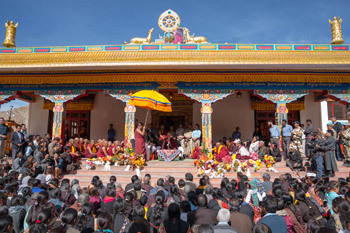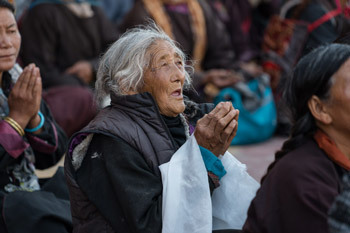Leh, Ladakh, J&K,
5 August 2016 –His Holiness the Dalai Lama departed early this morning
to visit Dakthog Monastery located approximately 40 kilometers from
Shewatsal Phodrang residence in Choglamsar, Leh, Ladakh. He was greeted
on the way by devout Ladakhis and Tibetans, many enthusiastically
displaying varieties of flowers on the side of the road next to their
house and holding traditional greeting scarves in their hands.
Upon
arrival at Dakthok Monastery in Sertri (or Sakti) Village, His Holiness
was received by the Lopon and former Lopon of the monastery. Before
entering the newly built Temple, His Holiness and the monks of Dakthok
and Namgyal Tantric College in McLeod Ganj recited auspicious verses
invoking buddhas and bodhisattvas. Inside the Temple, the central image
was of Guru Padmasambhava, flanked to his right and left, by Guru Dorje
Droloe and Guru Padma Gyalpo respectively. Following the consecration of
the triple Gurus one by one inside the temple, His Holiness was offered
a mandala by the head monks of Dakthok Monastery.
Then,
while His Holiness performed his special Tsog Offering to Guru Dorje
Doloe based on some texts from Rinchen Terdzod, the monks recited the
various prayers to Guru Rinpoche: Seven Line Prayer, Yearning Song of
Prayer: An Invocation of Compassionate Guru Padmasambhava, Dispelling
Obstacles Instantly and Achievement of Aspirations, and mantras of Guru
Dorje Doloe.
 |
| His Holiness the Dalai Lama speaking to a large
group locals and tourists gathered at Dakthog Monastery in Ladakh,
J&K, India on August 5, 2016. Photo/Tenzin Choejor/OHHDL |
When
the Tsog Offering was over His Holiness gave this year’s first public
talk in Ladakh at Dakthok to a large number of locals and westerners who
had gathered on the grounds of the monastery. His Holiness began by
introducing the Guru Dorje Doloe statue made by the late Taklung Tsetul
Rinpoche, the previous head of the Nyingma Buddhist tradition of Tibet,
at the behest of His Holiness himself. He said, “The Dorje Doloe statue
here in Ladakh was built to help the spiritual and temporal affairs of
the Tibetan cause. We have commissioned similar statues in Arunachal
Pradesh, Sikkim and somewhere in a border area.”
His
Holiness went on to tell the public that he finished his weeklong
retreat on Dorje Doloe yesterday and therefore as the concluding
practice he had come to Dakthok to make a Ritual Feast Offering. Though
at first His Holiness had no plans to meet the public, he mentioned that
the reason for meeting them was, “because so many of you have come here
I wished to say hello to you.”
“Your
faith has brought you here. But in Buddhism mere faith is not
sufficient. It emphasizes a faith borne of critical discerning faculty
of intelligence!” His Holiness went on to say the Buddha himself
emphasized the need for critical analysis of his teaching as he says:
Oh Bhikshus and wise people,
just as a gold is tested by burning, cutting and rubbing,
you should check my teaching thoroughly and then accept it.
But not because of your devotion to me!
Hence,
His Holiness pointed out that it is only the Buddha who asked his
followers to examine his teaching rather than accepting it on mere faith
and devotion. Whereas the founders of the other world religions have
all told their followers to believe in what they have revealed.

|
An elderly member of the local community listening to His Holiness the Dalai Lama speaking at Dakthog Monastery in Ladakh, J&K, India on August 5, 2016.
Photo/Tenzin Choejor/OHHDL
|
As logic is considered very important in the critical analysis of the Buddha’s
teaching, Nalanda masters like Nagarjuna and particularly Chandrakirti
scrutinized the scriptures and clearly differentiated between the
provisional teachings like Samdhinirmochana Sutra and the definite ones
by resorting to reason and logic. In order to point out the importance
of critical intellection in the Buddha’s teaching, His Holiness alluded
to the term ‘wisdom’ in the ‘Perfection of Wisdom’, the ultimate wisdom
mind of the buddhas, which is not referred by the other perfections such
as generosity.
So,
touching on the importance of using reason and logic to delve into the
depths of the teaching of the Buddha, His Holiness spoke about the three
aspects of phenomena—viz. the obvious/manifest, slightly hidden and
very hidden objects of knowledge—and said that the inferential logic
which is used to gain insight into the slightly hidden phenomena like
emptiness, we need to base on the empirical experience of the obvious
phenomenon such as the coarse level of cause and effect which is
observed in the world with our sensory perception. And through the
verification of the truth of the Buddha’s teaching pertaining to these
two aspects of knowledge we could infer the truth and infallible nature
of the teaching on the very hidden phenomena such as the very subtle
workings of the law of cause and effect, or karma.
In
connection with using reason and experiment to find the truth of the
teaching of the Buddha, His Holiness referred to his fruitful dialogues
with modern scientists—they are not religious but use rigorous methods
of investigation to understand reality—which began more than 30 years
ago. He said when he expressed his interest in discussions with
scientists over 40 years ago some western friend warned him against such
interaction. Nonetheless, he began discussions with western scientists
and he said, “Today, after holding dialogues with modern scientists for
over 30 years, I feel I have come out the winner!”
|
His Holiness the Dalai Lama speaking at Dakthog Monastery in Ladakh, J&K, India on August 5, 2016.
Photo/Tenzin Choejor/OHHDL
|
His
Holiness focused on the threefold understanding or wisdom gained
through study, reflection and meditation which progress from the former
to the latter. He advised the audience that the more than 300 volumes of
Kagyur and Tengyur literature are meant for our pursuit of knowledge in
order to build our conviction in the truth of the teaching, through
inferential logic, into experience, through meditation. So, we could see
how our faith in the teaching of the buddha, the teacher himself and so
on is grounded in the correct knowledge of buddhist philosophy through
critical examination and reason. His Holiness mentioned that the four
schools of philosophy in the Nalanda tradition differed because of their
interpretation of teaching of the same teacher, the Buddha. Because the
Nalanda tradition emphasized reason over scriptural citation masters
Dignaga and Dharmakirti wrote their books on epistemology all of which
today are found only in Tibetan translation.
In
conclusion, His Holiness told the audience, “I have reached 81 but I
still study and contemplate on texts from the Kagyur and Tengyur and
others whenever I have spare time”. His Holiness encouraged the young
and old with this advice, “It goes without saying that the younger
generation must study and learn the teaching of the Buddha. Even the
older people must study the teaching as Sakya Pandita says:
You must learn knowledge even if you were to die tomorrow.
You may not become a scholar in this very life
But as if taking your own wealth deposited
You would be drawing on it in the next life.
He
said he will be giving more detailed teaching in the days and weeks to
come and said goodbye to the gathering. After shaking hands with the
eager members of audience he returned to his residential palace in
Shewatsal Phodrang.



